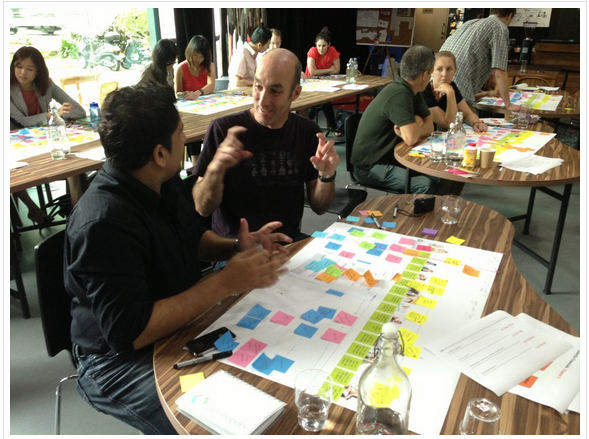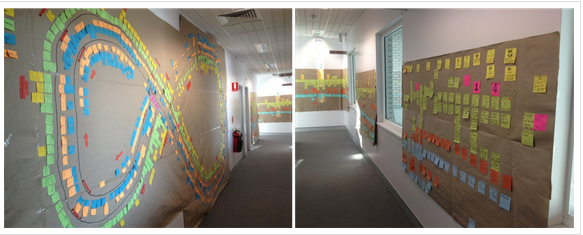
Consider the last time you made an important purchase. While deliberating over your options, you probably went through some fairly common decision-making steps:

Now, consider how this typical consumer process compares to the steps students take when selecting a college. Do you know how your school fares as prospective students move from point A to point Z along the decision-making timeline? What kinds of experiences do they have when interfacing with your institution? Can you pinpoint those critical points of loss or conversion?
In the business world, savvy marketing teams study the journey of target customers, continually tweaking messaging and refining touch points to improve experience and boost conversion rates. It’s not surprising that higher ed recruitment teams are following suit, customizing commercial journey maps to suit the unique needs of their college or university – essentially, taking a walk in their prospects’ shoes to identify and improve gaps in performance. According to Hubspot, this is the way every organization should function, “elevating, honoring and giving pride of place to customers.”
Student journey mapping is a diagnostic tool that tells you where you’re engaging prospects well, and at what point you’re losing them to competitors. More than just another marketing funnel, it’s an essential component of effective education lead generation, conversion, and sustained student loyalty.
Here are a few practical approaches for constructing student journey maps for your school:
1. Organize Your Student Personas
Few higher education marketing initiatives can get off the ground without a clear definition of student personas – and journey mapping is no exception. The first stage in investigating how prospects engage with your school during their decision-making journey is to define your most prominent student personas – the audiences you’re most likely to attract and convert.
Although each persona will progress along the decision-making timeline in a similar way, they may vary quite substantially in how they engage with each milestone. For example, one persona may spend a considerable amount of time following your posts on social media, while another scours your website for information on financial aid. Where one persona will approach your admissions staff via email, another will prefer to call and speak with a representative directly. Colleges with a nuanced understanding of their primary personas are in a better position to understand their journey as potential applicants.
2. Identify College-Student Touchpoints
How do prospective students hear about your school, investigate its offerings, engage online, and get in touch with admissions? To understand the conversion journey of your most prominent personas, begin by identifying their most likely touchpoints – the moments were leads intersect with your college both online and in person. Similar to models used by Adaptive Path and UX Apprentice, this initial step of journey mapping can be developed alongside a theoretical sales funnel:
Student Journey Map Phase One

Teamwork Yields Richer Results
It’s important to note that identifying typical touchpoints for each persona should be a collaborative effort between members of marketing and admissions teams. This is what CMO.com calls assembling a “cross-functional, customer-facing group” to build an “internal view” of how students interact with your institution. The process need not be high-tech – here’s how Designing CX approached journey mapping at a recent workshop in Singapore:

Designing CX’s Tabletop method uses the popular sticky-note approach to map out touchpoints for key personas, which allows the team to discuss, debate and move points as needed until a consensus is reached. Here is a somewhat more elaborate example from the University of New England in Australia, where students weighed in on touchpoints and expanded the map onto hallway walls:

More extensive maps can be built and added to over time – either online using a collaborative tool, or on paper using simple office supplies. Once you’ve established at what points prospective students are interfacing with your school, it’s time to move on to the next crucial stage in the journey mapping process.
3. Gather Feedback and Recognize Painpoints
For each one of its identified touchpoints, the college must consider the quality of the college/persona interaction. The only truly authentic way of generating this information, is to consult your students about their experience investigating and applying to your school. Some higher ed institutions run usability tests on their websites, recruiting students to perform tasks on the site and then report on their experience. Journey mapping expands this concept by looking at touchpoints beyond the scope of the college website, such as emails received from admissions and a visit to the college campus.
To gather feedback about the quality of both virtual and in-person touchpoints, colleges may want to administer a short survey to current students, or talk with prospects about their “journey” during the admission process. Schools could also pose questions about student experience on their social media platforms or school blog – whatever gets students responding. The feedback you gather provides an important second dimension to your phase one map:
Student Journey Map Phase Two

4. Strategize Improvements… and Repeat the Process!
By getting feedback on various key stages of your personas’ conversion journey, admissions and marketing teams can zero-in on identified painpoints, and strategize potential improvements. At this stage, sharing the journey map document is key in order to include as many stakeholders as possible, including website designers, admission staff, campus tour leaders, and content developers. The final phase of the journey map requires the input of several experts in order to be effective:
Student Journey Map: Final Product

Like many digital marketing initiatives, student journey mapping is a cyclical process of recognizing needs, developing and implementing strategies, measuring their impact – and starting all over again to make subsequent improvements. By tracking results using Google analytics, student feedback, and the observations of admissions staff, colleges will continue to expand and refine their student journey maps.
As higher ed tactics for engaging students grow increasingly technological, it’s important to consider the value and power of personalization – of humanizing the conversion process. By understanding and serving the needs of their primary personas, colleges minimize assumptions while maximizing the ROI for digital marketing campaigns.
Have you tried a version of student journey mapping? Tell us what you’ve learned about optimizing touchpoints between your college and its prospective students.






